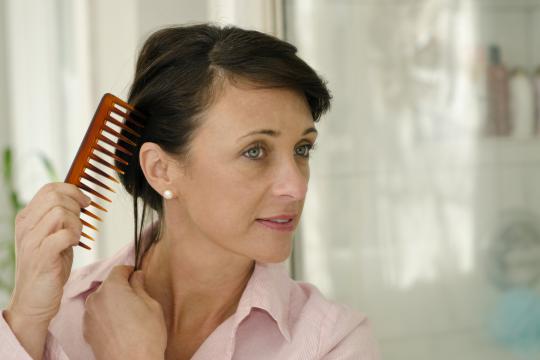
By: Genevieve Miller
While all of us lose an average of 50 to 100 hairs a day, sometimes we lose far more - to the point where it becomes painfully noticeable. To make matters worse, there is a veritable laundry list of factors that might be the cause; everything from certain over-the-counter drugs to stress to hormones to vitamin deficiencies and certain diseases and conditions. Some are easily reversed while others are not, which is why additional intervention may be necessary.
Female hair loss and female pattern baldness are rarely discussed, despite the fact that they have become significantly more prevalent in the last few decades – and researchers are trying to pinpoint the reasons why. Hormones might be to blame, but one thing is certain:
Women are not fond of losing their hair and will go to great lengths to try to restore it.
Having experienced hair loss first-hand, (twice in fact), I know what it’s like to see your hair go from full and beautiful to thin and lackluster. The first time was on account of powerful acne medication, (Accutane), to address a fairly resistant case of adult cystic acne. To me, the tradeoff was worth it. While my hair was never quite as thick as it once was pre-Accutane, I didn’t lose enough to consider it a total loss. The second time was post-partum, when, 6 months after my beautiful baby girl was born, my hair began falling out yet again – in clumps.
Fortunately, in my case, both hair loss events were not permanent, but the fear that they would be was there. I found myself googling a variety of solutions – and felt a little overwhelmed in the process. Today, there is a growing number of women who are experiencing permanent hair loss and are looking for options. What was a once-neglected segment of the hair loss population is now spawning a variety of new treatments and techniques for treating the condition, regardless of the cause, ranging from prescription pills like Viviscal to hair regrowth systems including Keranique, both of which have great patient satisfaction ratings, but neither of which is permanent. In other words, they will probably help, but you’ll be committed to a lifetime of use – which of course, can add up in terms of cost, so it might be worthwhile to consider more permanent options like hair transplantation. There are two popular procedures: The FUE and FUT methods, (Follicular Unit Extraction and Follicular Unit Transplantation respectively). The difference lies in how the hair follicles are extracted from the donor area.
FUT is a bit more invasive, as it involves removing a small strip of tissue from the back of the head, from which the donor hair follicles are extracted. It usually results in a small scar in the back of the head, but is concealed by any hairstyle, (whether short or long). The scar also fades over time.
In FUE transplants, each follicular unit is individually taken directly from the scalp, so there’s no removal of skin/tissue. Those individual hairs are then implanted into the scalp. It may require more than one session, depending on the size of the area needing transplanted follicles and was once used for smaller cases because of this. That said, new technologies are now available that are enabling physicians to accomplish much more in one sitting. One of those technologies is NeoGraft, a machine designed specifically for FUE, that is proving to be an attractive option for a large number of women looking for a permanent hair restoration solution.
Both techniques are pretty straightforward and simple, as outpatient procedures with some people returning to work the next day. Costs vary, but on average you’re looking at about $9,700. The good news of course is that it’s usually a one-and-done deal.
To address the ever-increasing number of women suffering from hair loss, NeoGraft just launched a new website, www.femalehairloss.com, providing women with all the information they need to seek help, make informed decisions, and feel like themselves again. It’s long-overdue in my book. I know too many women with conditions like Polycystic Ovary Syndrome, (which leads to hair loss in many patients), who spend a fortune on hair extensions and treatments to try to conceal the thinned out areas on their scalp. Their confidence is compromised because they worry that the extensions will fall out, or might be too noticeable. Without them, they are quite self-conscious and are always looking for alternative solutions.
Considering roughly 30 million women suffer from the condition, (40% of the hair loss population), it’s high-time someone stepped up to provide them with a resource for information. Hair loss has a significant social and psychological impact, so having a one-stop-shop for access to the latest research and information about signs, symptoms, treatments and physicians specializing in hair transplantation is a great idea.
Determining which path to take to restore hair loss is a very individual decision. Regardless of which you choose, you should find a board-certified physician, one specializing in hair restoration, in order to assess which option is best for you.


